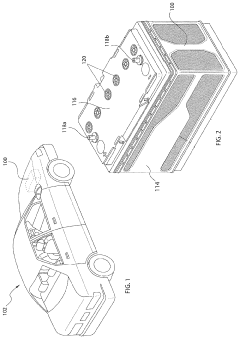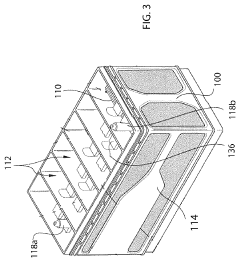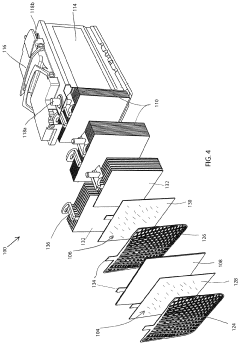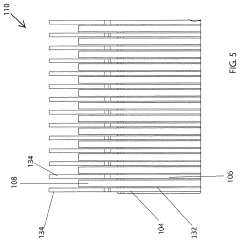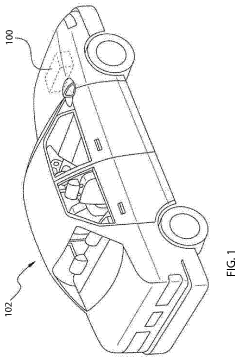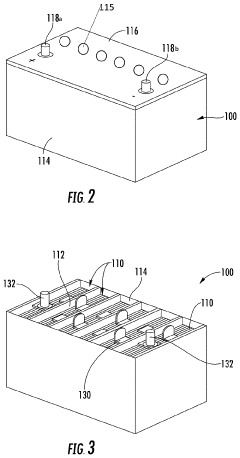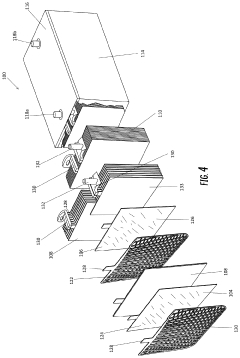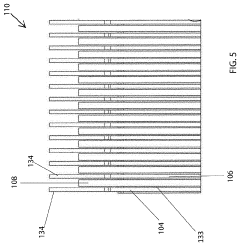Applications of AGM Battery in Distributed Urban Lighting Systems
AUG 8, 20259 MIN READ
Generate Your Research Report Instantly with AI Agent
Patsnap Eureka helps you evaluate technical feasibility & market potential.
AGM Battery Evolution and Objectives
Absorbed Glass Mat (AGM) battery technology has undergone significant evolution since its inception in the 1980s. Initially developed for military aircraft, AGM batteries have found widespread applications in various sectors, including distributed urban lighting systems. The technology's progression has been driven by the increasing demand for reliable, maintenance-free energy storage solutions in urban infrastructure.
The primary objective of AGM battery technology in distributed urban lighting systems is to provide a stable, long-lasting power source that can operate efficiently under diverse environmental conditions. This goal aligns with the broader aim of creating sustainable and smart urban environments. As cities worldwide strive to reduce energy consumption and minimize maintenance costs, AGM batteries have emerged as a viable solution for powering decentralized lighting networks.
Throughout its development, AGM battery technology has focused on improving several key performance metrics. These include enhancing cycle life, increasing energy density, improving charge acceptance rates, and extending operational temperature ranges. These advancements have been crucial in meeting the specific requirements of urban lighting systems, which demand reliable performance over extended periods with minimal intervention.
The evolution of AGM batteries has also been influenced by the growing emphasis on environmental sustainability. Manufacturers have made significant strides in reducing the environmental impact of battery production and disposal. This includes the development of more recyclable components and the implementation of cleaner manufacturing processes, aligning with global initiatives for greener urban infrastructure.
In the context of distributed urban lighting systems, AGM batteries have evolved to address unique challenges such as deep discharge resistance, rapid recharge capabilities, and resilience to frequent charge-discharge cycles. These improvements have made AGM batteries particularly well-suited for integration with renewable energy sources like solar panels, enabling the creation of self-sustaining lighting solutions for urban areas.
The objectives for future development of AGM battery technology in urban lighting applications are multifaceted. They include further extending battery lifespan to reduce replacement frequency, enhancing energy efficiency to minimize power consumption, and improving integration with smart city technologies. Additionally, there is a focus on developing more compact designs to facilitate easier installation and maintenance in urban environments with limited space.
As urban populations continue to grow and cities become increasingly interconnected, the role of AGM batteries in powering distributed lighting systems is expected to expand. Future objectives also encompass the development of advanced battery management systems that can optimize performance based on real-time usage patterns and environmental conditions, contributing to more adaptive and efficient urban lighting networks.
The primary objective of AGM battery technology in distributed urban lighting systems is to provide a stable, long-lasting power source that can operate efficiently under diverse environmental conditions. This goal aligns with the broader aim of creating sustainable and smart urban environments. As cities worldwide strive to reduce energy consumption and minimize maintenance costs, AGM batteries have emerged as a viable solution for powering decentralized lighting networks.
Throughout its development, AGM battery technology has focused on improving several key performance metrics. These include enhancing cycle life, increasing energy density, improving charge acceptance rates, and extending operational temperature ranges. These advancements have been crucial in meeting the specific requirements of urban lighting systems, which demand reliable performance over extended periods with minimal intervention.
The evolution of AGM batteries has also been influenced by the growing emphasis on environmental sustainability. Manufacturers have made significant strides in reducing the environmental impact of battery production and disposal. This includes the development of more recyclable components and the implementation of cleaner manufacturing processes, aligning with global initiatives for greener urban infrastructure.
In the context of distributed urban lighting systems, AGM batteries have evolved to address unique challenges such as deep discharge resistance, rapid recharge capabilities, and resilience to frequent charge-discharge cycles. These improvements have made AGM batteries particularly well-suited for integration with renewable energy sources like solar panels, enabling the creation of self-sustaining lighting solutions for urban areas.
The objectives for future development of AGM battery technology in urban lighting applications are multifaceted. They include further extending battery lifespan to reduce replacement frequency, enhancing energy efficiency to minimize power consumption, and improving integration with smart city technologies. Additionally, there is a focus on developing more compact designs to facilitate easier installation and maintenance in urban environments with limited space.
As urban populations continue to grow and cities become increasingly interconnected, the role of AGM batteries in powering distributed lighting systems is expected to expand. Future objectives also encompass the development of advanced battery management systems that can optimize performance based on real-time usage patterns and environmental conditions, contributing to more adaptive and efficient urban lighting networks.
Urban Lighting Market Analysis
The urban lighting market has experienced significant growth in recent years, driven by rapid urbanization, smart city initiatives, and increasing focus on energy efficiency. As cities expand and modernize, the demand for reliable and sustainable lighting solutions has surged, creating a fertile ground for innovative technologies like AGM (Absorbent Glass Mat) batteries in distributed urban lighting systems.
The global urban lighting market is projected to reach substantial value in the coming years, with LED-based solutions dominating the landscape. This growth is fueled by government initiatives to reduce energy consumption and carbon emissions, as well as the need for improved public safety and aesthetics in urban areas. The shift towards smart lighting systems, which incorporate sensors, connectivity, and advanced control mechanisms, has further accelerated market expansion.
In the context of distributed urban lighting systems, the market shows a clear trend towards decentralized power sources and energy storage solutions. This is where AGM batteries come into play, offering a reliable and efficient energy storage option for urban lighting applications. The demand for such distributed systems is driven by the need for resilience against power outages, flexibility in installation, and the ability to harness renewable energy sources like solar power.
The Asia-Pacific region leads the urban lighting market growth, with China and India at the forefront due to their rapid urbanization and infrastructure development. North America and Europe follow closely, driven by smart city projects and the replacement of outdated lighting infrastructure. The Middle East and Africa are emerging markets, showing potential for significant growth in urban lighting solutions.
Key market drivers include the increasing adoption of IoT-enabled lighting systems, the push for energy-efficient solutions to meet sustainability goals, and the growing emphasis on smart city development. The integration of AGM batteries in these systems addresses the critical need for reliable power storage, especially in areas with unstable grid connections or those aiming to reduce dependence on the main power grid.
However, the market faces challenges such as high initial installation costs, the need for standardization in smart lighting protocols, and concerns about data security in connected lighting systems. Despite these hurdles, the overall trajectory of the urban lighting market remains positive, with technological advancements and decreasing costs of LED and battery technologies expected to drive further adoption.
The competitive landscape of the urban lighting market is diverse, featuring both established lighting manufacturers and new entrants specializing in smart lighting solutions. As the market evolves, partnerships between lighting companies, battery manufacturers, and software providers are becoming increasingly common, fostering innovation in distributed urban lighting systems incorporating AGM battery technology.
The global urban lighting market is projected to reach substantial value in the coming years, with LED-based solutions dominating the landscape. This growth is fueled by government initiatives to reduce energy consumption and carbon emissions, as well as the need for improved public safety and aesthetics in urban areas. The shift towards smart lighting systems, which incorporate sensors, connectivity, and advanced control mechanisms, has further accelerated market expansion.
In the context of distributed urban lighting systems, the market shows a clear trend towards decentralized power sources and energy storage solutions. This is where AGM batteries come into play, offering a reliable and efficient energy storage option for urban lighting applications. The demand for such distributed systems is driven by the need for resilience against power outages, flexibility in installation, and the ability to harness renewable energy sources like solar power.
The Asia-Pacific region leads the urban lighting market growth, with China and India at the forefront due to their rapid urbanization and infrastructure development. North America and Europe follow closely, driven by smart city projects and the replacement of outdated lighting infrastructure. The Middle East and Africa are emerging markets, showing potential for significant growth in urban lighting solutions.
Key market drivers include the increasing adoption of IoT-enabled lighting systems, the push for energy-efficient solutions to meet sustainability goals, and the growing emphasis on smart city development. The integration of AGM batteries in these systems addresses the critical need for reliable power storage, especially in areas with unstable grid connections or those aiming to reduce dependence on the main power grid.
However, the market faces challenges such as high initial installation costs, the need for standardization in smart lighting protocols, and concerns about data security in connected lighting systems. Despite these hurdles, the overall trajectory of the urban lighting market remains positive, with technological advancements and decreasing costs of LED and battery technologies expected to drive further adoption.
The competitive landscape of the urban lighting market is diverse, featuring both established lighting manufacturers and new entrants specializing in smart lighting solutions. As the market evolves, partnerships between lighting companies, battery manufacturers, and software providers are becoming increasingly common, fostering innovation in distributed urban lighting systems incorporating AGM battery technology.
AGM Battery Technology Status
Absorbed Glass Mat (AGM) battery technology has made significant strides in recent years, particularly in its application to distributed urban lighting systems. The current status of AGM battery technology showcases its advantages in terms of maintenance-free operation, high discharge rates, and excellent cycle life, making it an ideal choice for urban lighting applications.
AGM batteries have evolved to offer improved energy density and longer lifespan compared to traditional lead-acid batteries. The latest advancements in AGM technology have resulted in batteries that can withstand deeper discharge cycles without significant degradation, a crucial feature for urban lighting systems that operate on a daily cycle.
The integration of AGM batteries in distributed urban lighting systems has been facilitated by their compact design and spill-proof nature. This allows for flexible installation options, including pole-mounted configurations, which are essential in urban environments where space is often at a premium.
Recent developments in AGM battery management systems have further enhanced their performance in urban lighting applications. These systems optimize charging and discharging cycles, monitor battery health, and provide real-time data on battery status. This level of control and monitoring is particularly beneficial in distributed systems, where remote management is crucial for efficient operation and maintenance.
The current generation of AGM batteries used in urban lighting systems demonstrates improved temperature tolerance, allowing for reliable operation across a wide range of environmental conditions. This characteristic is especially valuable in urban settings where batteries may be exposed to varying temperatures throughout the year.
Advancements in electrode design and electrolyte composition have contributed to the increased efficiency and longevity of AGM batteries. These improvements have resulted in batteries that can maintain consistent performance over extended periods, reducing the frequency of replacements and lowering the overall cost of ownership for urban lighting infrastructure.
The adoption of AGM batteries in distributed urban lighting systems has been accelerated by their compatibility with renewable energy sources, particularly solar power. This synergy allows for the creation of off-grid or hybrid lighting solutions, contributing to the sustainability goals of many urban areas.
While AGM battery technology has made significant progress, ongoing research focuses on further improving energy density, cycle life, and charging efficiency. These efforts aim to address the increasing demands of smart city initiatives and the growing complexity of urban lighting systems.
AGM batteries have evolved to offer improved energy density and longer lifespan compared to traditional lead-acid batteries. The latest advancements in AGM technology have resulted in batteries that can withstand deeper discharge cycles without significant degradation, a crucial feature for urban lighting systems that operate on a daily cycle.
The integration of AGM batteries in distributed urban lighting systems has been facilitated by their compact design and spill-proof nature. This allows for flexible installation options, including pole-mounted configurations, which are essential in urban environments where space is often at a premium.
Recent developments in AGM battery management systems have further enhanced their performance in urban lighting applications. These systems optimize charging and discharging cycles, monitor battery health, and provide real-time data on battery status. This level of control and monitoring is particularly beneficial in distributed systems, where remote management is crucial for efficient operation and maintenance.
The current generation of AGM batteries used in urban lighting systems demonstrates improved temperature tolerance, allowing for reliable operation across a wide range of environmental conditions. This characteristic is especially valuable in urban settings where batteries may be exposed to varying temperatures throughout the year.
Advancements in electrode design and electrolyte composition have contributed to the increased efficiency and longevity of AGM batteries. These improvements have resulted in batteries that can maintain consistent performance over extended periods, reducing the frequency of replacements and lowering the overall cost of ownership for urban lighting infrastructure.
The adoption of AGM batteries in distributed urban lighting systems has been accelerated by their compatibility with renewable energy sources, particularly solar power. This synergy allows for the creation of off-grid or hybrid lighting solutions, contributing to the sustainability goals of many urban areas.
While AGM battery technology has made significant progress, ongoing research focuses on further improving energy density, cycle life, and charging efficiency. These efforts aim to address the increasing demands of smart city initiatives and the growing complexity of urban lighting systems.
Current AGM Solutions for Urban Lighting
01 AGM battery structure and design improvements
Advancements in AGM battery structure and design focus on enhancing performance and efficiency. These improvements include optimized electrode arrangements, innovative separators, and refined internal configurations to increase capacity, reduce internal resistance, and improve overall battery life.- AGM battery structure and design: Innovations in the structure and design of AGM (Absorbent Glass Mat) batteries, including improvements in electrode arrangement, separator materials, and overall battery construction to enhance performance and efficiency.
- Electrolyte management in AGM batteries: Advancements in electrolyte management systems for AGM batteries, focusing on optimizing electrolyte distribution, reducing electrolyte loss, and improving overall battery life and performance.
- Thermal management of AGM batteries: Development of thermal management solutions for AGM batteries, including cooling systems and heat dissipation mechanisms to maintain optimal operating temperatures and extend battery lifespan.
- AGM battery monitoring and control systems: Implementation of advanced monitoring and control systems for AGM batteries, incorporating sensors, data analysis, and intelligent management to optimize battery performance and predict maintenance needs.
- AGM battery manufacturing processes: Improvements in AGM battery manufacturing processes, including automated assembly techniques, quality control measures, and innovative production methods to enhance battery consistency and reduce manufacturing costs.
02 Electrolyte management and absorption techniques
Developments in electrolyte management for AGM batteries involve improved absorption methods and materials. These techniques aim to enhance electrolyte distribution, prevent leakage, and maintain optimal moisture levels within the battery, contributing to better performance and longer lifespan.Expand Specific Solutions03 Thermal management and safety features
Innovations in thermal management and safety features for AGM batteries focus on preventing overheating, improving heat dissipation, and enhancing overall battery safety. These advancements include novel cooling systems, temperature monitoring mechanisms, and protective designs to ensure stable and safe operation.Expand Specific Solutions04 Charging and discharging control systems
Advanced charging and discharging control systems for AGM batteries aim to optimize battery performance and longevity. These systems incorporate intelligent algorithms, precise voltage regulation, and adaptive charging strategies to maximize efficiency and prevent overcharging or deep discharging.Expand Specific Solutions05 Manufacturing processes and quality control
Improvements in AGM battery manufacturing processes and quality control measures focus on enhancing production efficiency and ensuring consistent product quality. These advancements include automated assembly techniques, precise material handling, and rigorous testing procedures to produce high-performance and reliable AGM batteries.Expand Specific Solutions
Key AGM Battery Manufacturers
The AGM battery market for distributed urban lighting systems is in a growth phase, driven by increasing urbanization and smart city initiatives. The market size is expanding, with a projected CAGR of 5-7% over the next five years. Technologically, AGM batteries are mature but still evolving, with companies like Daramic LLC and Stryten Energy LLC leading in separator and energy storage innovations. Major players such as Enphase Energy and HELLA GmbH & Co. KGaA are focusing on integrating AGM batteries into smart lighting solutions, while universities like the University of Strathclyde are conducting research to improve efficiency and lifespan. The competitive landscape is diverse, with both established manufacturers and new entrants vying for market share in this growing sector.
Stryten Energy LLC
Technical Solution: Stryten Energy has developed advanced AGM (Absorbent Glass Mat) battery technology specifically tailored for distributed urban lighting systems. Their solution incorporates high-performance AGM batteries with enhanced cycle life and deep discharge capabilities. The batteries feature a proprietary valve-regulated design that minimizes electrolyte loss and allows for maintenance-free operation[1]. Stryten's AGM batteries are engineered to withstand extreme temperature variations, making them ideal for outdoor urban environments. The company has also implemented smart battery management systems that optimize charging and discharging cycles, extending battery life and improving overall system efficiency[2]. These batteries are designed to integrate seamlessly with renewable energy sources, such as solar panels, to create hybrid power solutions for urban lighting infrastructure.
Strengths: Long cycle life, maintenance-free operation, and excellent performance in extreme temperatures. Weaknesses: Higher initial cost compared to traditional lead-acid batteries and potential limitations in energy density.
FIAMM Energy Technology SpA
Technical Solution: FIAMM Energy Technology has developed a specialized AGM battery solution for distributed urban lighting systems. Their AGM batteries feature a high-density plate design that maximizes power output while minimizing footprint, crucial for space-constrained urban installations[3]. FIAMM's technology incorporates advanced lead-calcium alloys that reduce water consumption and extend battery life. The company has also implemented a unique microporous separator technology that enhances electrolyte absorption and improves charge acceptance rates[4]. FIAMM's AGM batteries are designed with a robust casing to withstand vibrations and physical stress common in urban environments. Additionally, they have developed a smart monitoring system that provides real-time data on battery health and performance, enabling predictive maintenance and optimized energy management for urban lighting networks.
Strengths: High power density, improved charge acceptance, and smart monitoring capabilities. Weaknesses: Potentially higher manufacturing costs and limited flexibility in battery shape and size.
AGM Battery Innovations for Lighting
Absorbent glass mat battery
PatentActiveUS11936032B2
Innovation
- The development of a lead-acid battery with a negative electrode comprising a leady oxide, a synthetic organic expander, conductive carbons, and very fine particle barium sulfate, along with an absorbent glass mat separator, which enhances charge acceptance and cycling performance by improving the electrochemical active material composition and structure.
Compact absorbent glass mat battery
PatentPendingUS20200212504A1
Innovation
- A compact AGM lead acid battery design with a reduced lead content and smaller size, utilizing a container with electrically connected cells and an absorbent glass mat interleaved between positive and negative plates, achieving improved cycle life and higher CCA performance.
Energy Efficiency Regulations
Energy efficiency regulations play a crucial role in shaping the adoption and implementation of AGM (Absorbent Glass Mat) batteries in distributed urban lighting systems. These regulations are designed to promote sustainable energy practices and reduce overall energy consumption in urban environments. As cities worldwide strive to become more energy-efficient and environmentally friendly, lighting systems have become a focal point for improvement.
Many countries and regions have established specific energy efficiency standards for outdoor lighting, including street lamps and other urban illumination systems. These standards often set minimum requirements for luminous efficacy, power consumption, and overall system efficiency. For instance, the European Union's Ecodesign Directive includes regulations for street lighting that mandate minimum efficacy levels and maximum power consumption limits.
In the context of AGM batteries in distributed urban lighting systems, energy efficiency regulations impact both the battery technology itself and the overall system design. AGM batteries are known for their high efficiency and low self-discharge rates, making them well-suited for meeting stringent energy efficiency requirements. However, regulations may also dictate specific performance criteria for energy storage systems in urban lighting applications, such as minimum cycle life, depth of discharge limits, and charging efficiency.
Furthermore, energy efficiency regulations often encourage the integration of smart control systems and renewable energy sources into urban lighting infrastructure. This has led to the development of hybrid systems that combine AGM batteries with solar panels or wind turbines, maximizing energy efficiency and reducing reliance on the grid. Some regulations may provide incentives or mandates for the incorporation of such renewable energy components in urban lighting projects.
The impact of these regulations extends beyond the technical specifications of lighting systems. Many cities are required to conduct regular energy audits and report on their progress in reducing energy consumption. This has driven the adoption of advanced monitoring and control systems that can precisely track and optimize the performance of AGM battery-based lighting solutions. Additionally, lifecycle assessment requirements in some regulations have prompted manufacturers to focus on the long-term sustainability and recyclability of AGM batteries used in urban lighting applications.
As energy efficiency regulations continue to evolve, they are likely to drive further innovations in AGM battery technology and its applications in distributed urban lighting systems. This may include advancements in battery chemistry to improve energy density and cycle life, as well as the development of more sophisticated energy management systems that can dynamically adjust lighting output based on real-time conditions and energy availability.
Many countries and regions have established specific energy efficiency standards for outdoor lighting, including street lamps and other urban illumination systems. These standards often set minimum requirements for luminous efficacy, power consumption, and overall system efficiency. For instance, the European Union's Ecodesign Directive includes regulations for street lighting that mandate minimum efficacy levels and maximum power consumption limits.
In the context of AGM batteries in distributed urban lighting systems, energy efficiency regulations impact both the battery technology itself and the overall system design. AGM batteries are known for their high efficiency and low self-discharge rates, making them well-suited for meeting stringent energy efficiency requirements. However, regulations may also dictate specific performance criteria for energy storage systems in urban lighting applications, such as minimum cycle life, depth of discharge limits, and charging efficiency.
Furthermore, energy efficiency regulations often encourage the integration of smart control systems and renewable energy sources into urban lighting infrastructure. This has led to the development of hybrid systems that combine AGM batteries with solar panels or wind turbines, maximizing energy efficiency and reducing reliance on the grid. Some regulations may provide incentives or mandates for the incorporation of such renewable energy components in urban lighting projects.
The impact of these regulations extends beyond the technical specifications of lighting systems. Many cities are required to conduct regular energy audits and report on their progress in reducing energy consumption. This has driven the adoption of advanced monitoring and control systems that can precisely track and optimize the performance of AGM battery-based lighting solutions. Additionally, lifecycle assessment requirements in some regulations have prompted manufacturers to focus on the long-term sustainability and recyclability of AGM batteries used in urban lighting applications.
As energy efficiency regulations continue to evolve, they are likely to drive further innovations in AGM battery technology and its applications in distributed urban lighting systems. This may include advancements in battery chemistry to improve energy density and cycle life, as well as the development of more sophisticated energy management systems that can dynamically adjust lighting output based on real-time conditions and energy availability.
Smart City Integration Prospects
The integration of AGM (Absorbent Glass Mat) batteries in distributed urban lighting systems presents a significant opportunity for smart city development. These advanced battery systems offer numerous advantages that align with the goals of creating more efficient, sustainable, and intelligent urban environments.
AGM batteries can serve as a crucial component in the development of smart street lighting networks. By incorporating these batteries into individual light poles or distributed control nodes, cities can create a more resilient and flexible lighting infrastructure. This decentralized approach allows for better energy management and reduced reliance on the central power grid.
One of the key benefits of using AGM batteries in urban lighting systems is their ability to support off-grid or hybrid power solutions. This capability enables the integration of renewable energy sources, such as solar panels, directly into street lighting infrastructure. As a result, cities can reduce their carbon footprint and energy costs while improving the overall sustainability of their urban lighting systems.
The implementation of AGM batteries in distributed lighting systems also facilitates the adoption of adaptive lighting strategies. With localized energy storage, individual light fixtures can adjust their output based on real-time conditions, such as pedestrian traffic or weather patterns. This dynamic approach to lighting not only enhances energy efficiency but also improves public safety and comfort.
Furthermore, the integration of AGM batteries enables the creation of a more intelligent and connected urban infrastructure. These battery-powered nodes can serve as hubs for various smart city technologies, including environmental sensors, Wi-Fi hotspots, and traffic monitoring systems. This multi-functional approach maximizes the value of existing street lighting infrastructure and supports the broader goals of smart city initiatives.
The reliability and long lifespan of AGM batteries make them particularly well-suited for urban applications. Their maintenance-free nature and ability to withstand extreme temperatures contribute to reduced operational costs and improved system longevity. This durability is essential for ensuring the consistent performance of critical urban infrastructure.
As cities continue to explore ways to enhance their sustainability and livability, the integration of AGM batteries in distributed urban lighting systems represents a promising avenue for innovation. By leveraging these advanced energy storage solutions, municipalities can create more resilient, efficient, and intelligent urban environments that better serve the needs of their residents and support long-term sustainability goals.
AGM batteries can serve as a crucial component in the development of smart street lighting networks. By incorporating these batteries into individual light poles or distributed control nodes, cities can create a more resilient and flexible lighting infrastructure. This decentralized approach allows for better energy management and reduced reliance on the central power grid.
One of the key benefits of using AGM batteries in urban lighting systems is their ability to support off-grid or hybrid power solutions. This capability enables the integration of renewable energy sources, such as solar panels, directly into street lighting infrastructure. As a result, cities can reduce their carbon footprint and energy costs while improving the overall sustainability of their urban lighting systems.
The implementation of AGM batteries in distributed lighting systems also facilitates the adoption of adaptive lighting strategies. With localized energy storage, individual light fixtures can adjust their output based on real-time conditions, such as pedestrian traffic or weather patterns. This dynamic approach to lighting not only enhances energy efficiency but also improves public safety and comfort.
Furthermore, the integration of AGM batteries enables the creation of a more intelligent and connected urban infrastructure. These battery-powered nodes can serve as hubs for various smart city technologies, including environmental sensors, Wi-Fi hotspots, and traffic monitoring systems. This multi-functional approach maximizes the value of existing street lighting infrastructure and supports the broader goals of smart city initiatives.
The reliability and long lifespan of AGM batteries make them particularly well-suited for urban applications. Their maintenance-free nature and ability to withstand extreme temperatures contribute to reduced operational costs and improved system longevity. This durability is essential for ensuring the consistent performance of critical urban infrastructure.
As cities continue to explore ways to enhance their sustainability and livability, the integration of AGM batteries in distributed urban lighting systems represents a promising avenue for innovation. By leveraging these advanced energy storage solutions, municipalities can create more resilient, efficient, and intelligent urban environments that better serve the needs of their residents and support long-term sustainability goals.
Unlock deeper insights with Patsnap Eureka Quick Research — get a full tech report to explore trends and direct your research. Try now!
Generate Your Research Report Instantly with AI Agent
Supercharge your innovation with Patsnap Eureka AI Agent Platform!
